Botanical Name: Artemisia schmidtiana
Common Name: silver mound
Family: Asteraceae
Distribution/Origin: Japan
Leaf: silvery green in color, tomentose, fine texture, twice palmately divided, fine textured
Bud: small silver buds, alternate
Flower: small yellow to white flowers, small silver buds
Fruit/Seed: achene
Stem/Bark: old growth is woody
Size: up to 1’ height by 1.5’ spread
Habit: spreading
Form: mound
Soil conditions: well drained, infertile
Moisture: even moisture
Sun: full to partial sun
Exposure: tolerant of poor soils, drought, excessive heat
Landscape use: color contrast, edging, specimen plant, borders, mass plantings, rock garden
Notes: foliage may rot or rust under high humidity, often needs to be divided


Botanical Name: Brachyglottis greyi

Botanical Name: Brachyglottis greyi
Common Name: daisy bush
Family: Asteraceae
Distribution/Origin: New Zealand, Australia
Leaf: simple, oblong to ovate, wavy margins, green surfaces with white undersides, margins white
Bud: alternate
Flower: yellow panicles, daisy like
Fruit/Seed: achenes
Stem/Bark: stems curve somewhat, covered in down
Size: up to 6’ height by 8’ spread
Habit: spreading
Form: mounding
Soil conditions: well drained, adaptable, rocky soils
Moisture: evenly moist
Sun: full sun
Exposure: tolerant of poor soils, dry conditions, wind and coastal exposure
Landscape use: hedge, flower borders, beds, city and courtyard gardens, rock gardens
Notes: susceptible to phytophthora in moist soils, flowers best in sunny conditions

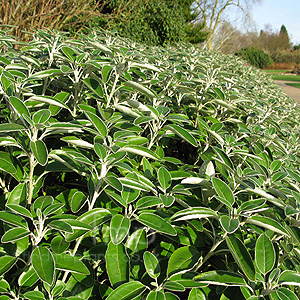


Botanical Name: Cistus x hybridus
Common Name: rock rose
Family: Cistaceae
Distribution/Origin: Mediterranean
Leaf: simple, entire margins, ruffled undulating, rough texture, prickles on leaf undersides, greyish cast, petioles fused where they meet stems
Bud: opposite, red
Flower: papery blooms, 5 petaled, white with yellow centers, simple
Fruit/Seed: insignificant
Stem/Bark: prickles on stems
Size: up to 3’ height by 5’ spread
Habit: dense
Form: mounding
Soil conditions: rocky/sandy, adaptable, well drained
Moisture: low
Sun: full sun
Exposure: drought tolerant, heat tolerant, erosion control
Landscape use: planters, low maintenance zones with no irrigation, foundation, mixed border
Notes: hybrid of Cistus parviflorus and Cistus salvifolius. Rich in oil that was once valued for the Old World perfume trade.
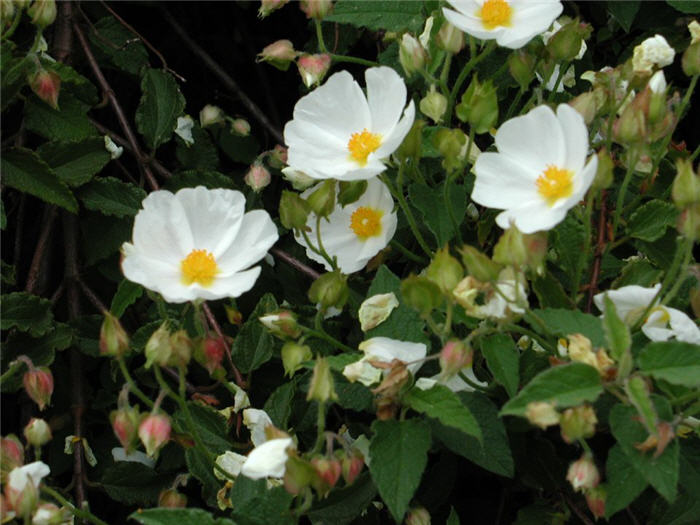



Botanical Name: Cistus laurifolius
Common Name: laurel leaved rock rose
Family: Cistaceae
Distribution/Origin: Mediterranean
Leaf: simple, leathery texture, dull grey-green color, ovate, sticky
Bud: opposite
Flower: 5 petalled, bowl shaped, white, pink or purplish in color, papery
Fruit/Seed: achenes
Stem/Bark: reddish brown, exfoliating
Size: 4-6’ height, 4-6’ spread
Habit: upright, then sprawling
Form: bushy, open
Soil conditions: well drained, adaptable
Moisture: minimal
Sun: full sun
Exposure: sheltered
Landscape use: low maintenance groundcover, courtyards, cottage gardens
Notes: drought resistance, short lived
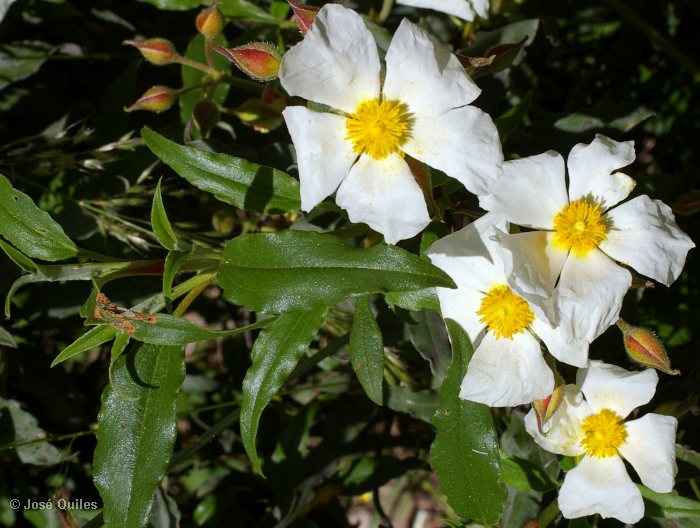



Botanical Name: Helianthemum x hybridum
Common Name: common rock rose
Family: Cistaceae
Distribution/Origin: Europe, garden origin
Leaf: simple, pubescent surfaces, pale green, lanceolate to obovate
Bud:
Flower: raceme to cyme, simple, perfect
Fruit/Seed: dry capsule
Stem/Bark: brown lightly fissured bark, stems have pubescence
Size: .5’ height, 1-3’ spread
Habit: upright, multi stemmed, spreading
Form: mounding
Soil conditions: well draining, mineral
Moisture: lightly moist to dry
Sun: full to partial sun
Exposure: tolerant of drought
Landscape use: beds, borders, groundcover
Notes:

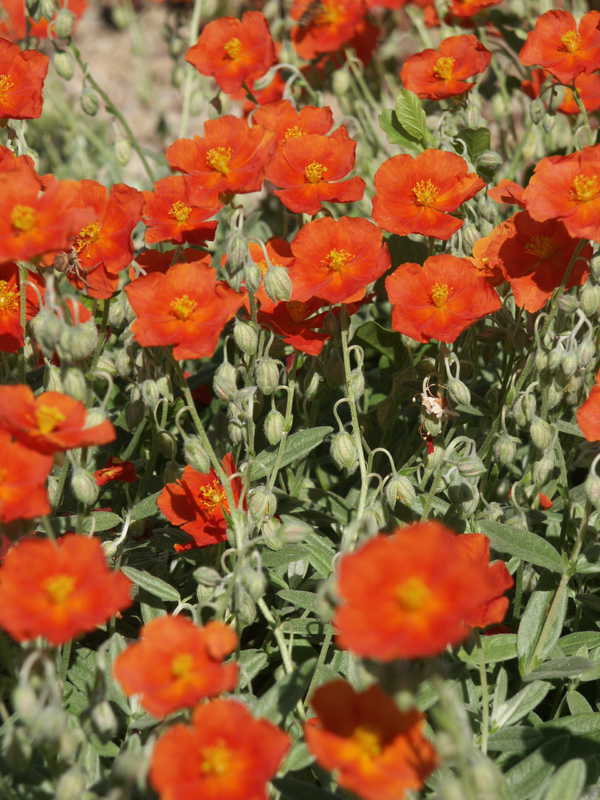


Botanical Name: Laurus nobilis
Common Name: bay laurel
Family: Lauraceae
Distribution/Origin: Mediterranean
Leaf: glossy surfaces, aromatic, entire margins - sometimes undulating, leathery, elliptic to oval
Bud:
Flower: male and female flowers on separate plants, pale yellow to green, borne in pairs beside a leaf
Fruit/Seed: small, shiny black berry like drupe containing single seed
Stem/Bark: pale gray, smooth
Size: 10-30’ height, 5-20’ spread
Habit: dense, multistemmed
Form: pyramidal, upright
Soil conditions: well drained, sandy loams
Moisture: evenly moist to dry
Sun: semi shade to sun
Exposure: drought tolerant
Landscape use: herb garden, shaded areas, large landscape tree, screen
Notes: popular in many types of cuisine. Caesars crown was woven with bay leaves.
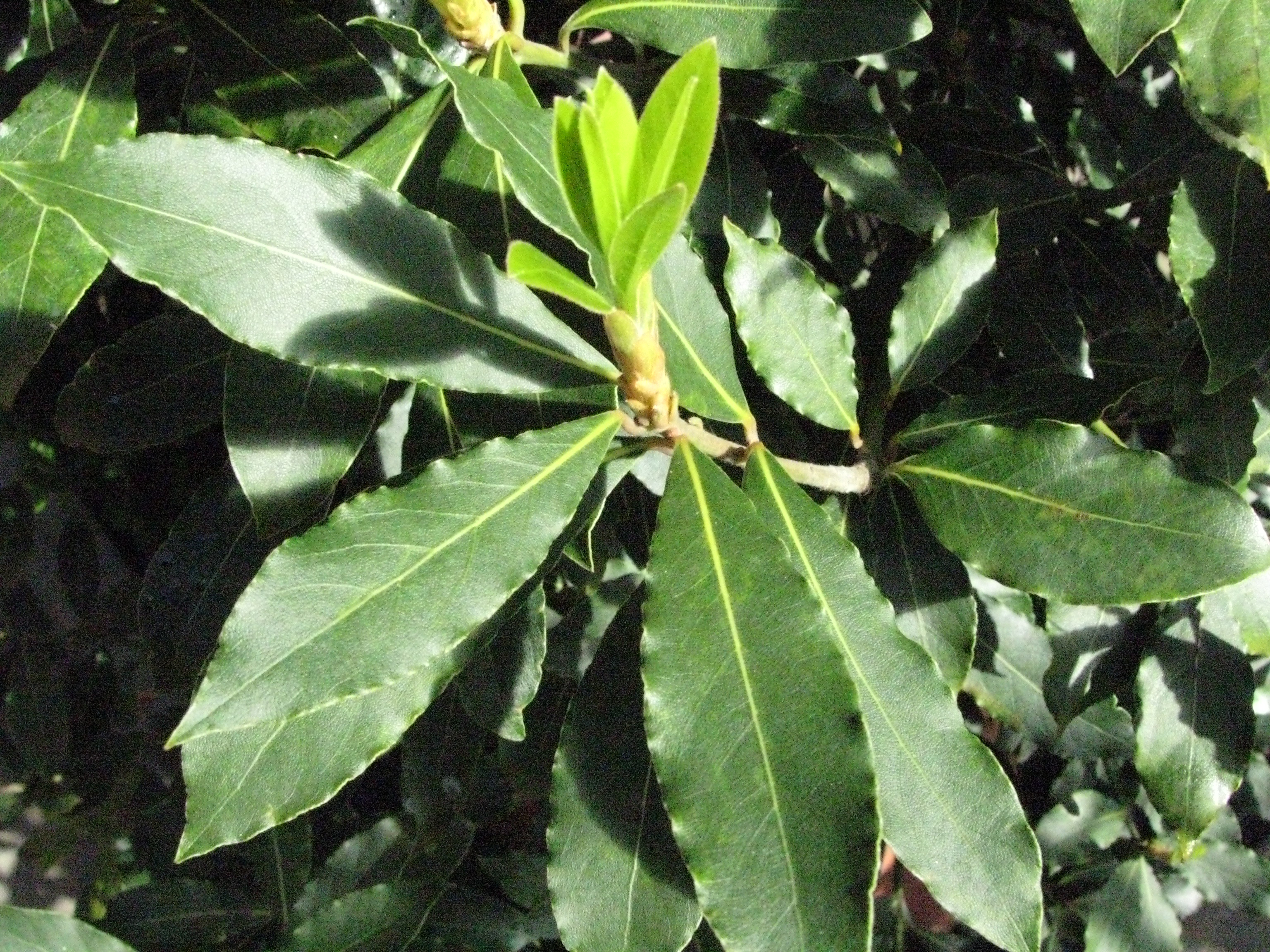



Botanical Name: Lavandula angustifolia
Common Name: English lavender
Family: Lamiaceae
Distribution/Origin: mediterranean, Pyrenees, northern Spain
Leaf: narrow, simple, entire margins or slightly toothed or lobed, silverish grey, lanceolate-linear, tomentose
Bud: opposite
Flower: dense spikes, pinkish purple on slender leafless stems, small tubular blooms
Fruit/Seed: brown nut
Stem/Bark: green,
Size: 3-6.5’ height, 2-3’ spread
Habit: bushy, dense, spreading
Form: rounded, upright, oval
Soil conditions: light sandy soils, well drained, can grow in very alkaline soils
Moisture: dry
Sun: full sun
Exposure: shelter from cold winter temperatures and winds
Landscape use: hedge, beds, banks, slopes, cottage gardens
Notes: very useful in the treatment of burns, bites and wounds. Genus ‘lavo’ comes from latin for “I wash” referring to plants ancient use as a aromatic was. Attractive for bees and pollinating insects

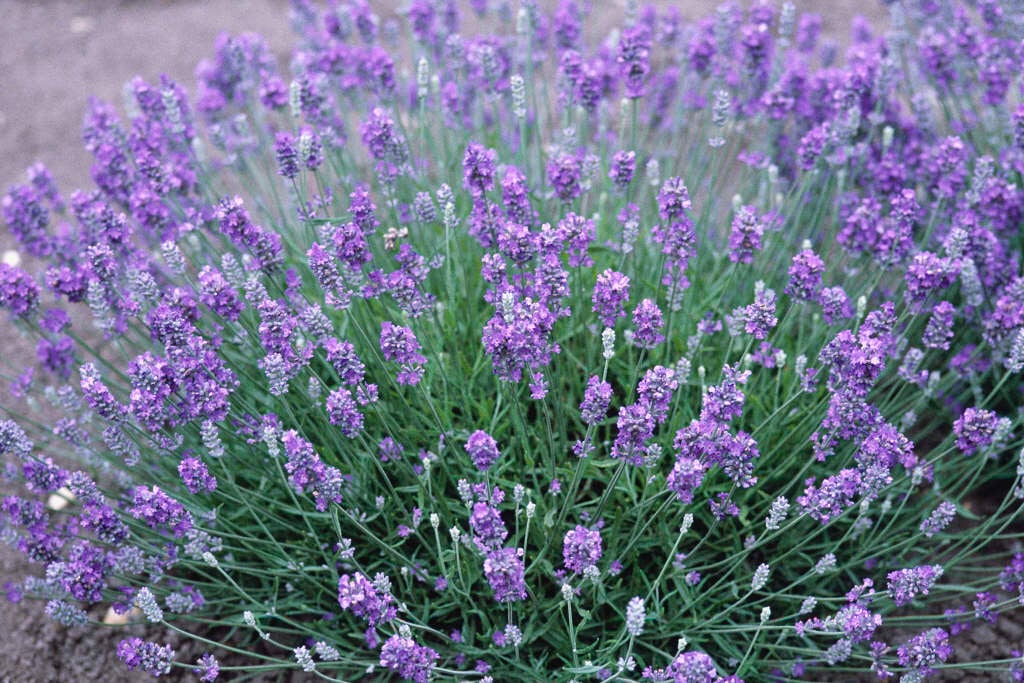

Botanical Name: Lavandula stoechas
Common Name: French lavender, Spanish lavender
Family: Lamiaceae
Distribution/Origin: Europe
Leaf: linear, entire margins, silverish grey foliage, pinnate venation, soft/flexible, tomentose
Bud: opposite
Flower: tight spike like verticillaster, purple petals out the top, perfect, sterile bracts
Fruit/Seed: nut, not showy, enclosed in persistent calyx
Stem/Bark: silvery grey to green, tomentose
Size: 1-3’ height, 2-4’ spread
Habit: spreading, upright
Form: mounded, round
Soil conditions: well drained
Moisture: dry
Sun: full sun
Exposure:
Landscape use: ground cover, mass planting, bed, cottage gardens, hedge, mixed borders
Notes: regarded as an invasive weed in Australia as well as Spain


Botanical Name: Perovskia atriplicifolia
Common Name: Russian sage
Family: Lamiaceae
Distribution/Origin: central Asia
Leaf: dusty green, deeply lobed, finely textured, simple, lanceolate, crenate/dentate margins, pinnately lobed
Bud: opposite
Flower: loose panicle of purple spikes, that rise up like building spires, verticillaster, tubular
Fruit/Seed: brown nut
Stem/Bark: square, rigid, older wood develops rough and flaking bark
Size: 4-6’ height, 3-5’ spread
Habit: arching, spreading, upright
Form: oval-vertical
Soil conditions: rocky, gravelly, well drained
Moisture: dry, suitable for xeriscaping
Sun: full sun
Exposure:
Landscape use: mass borders, beds, fall interest, xeriscape gardens, summer interest, tall background
Notes:




Botanical Name: Phlomis fruticosa
Common Name: Jerusalem sage
Family: Lamiaceae
Distribution/Origin: mediterranean
Leaf: oval, wrinkled, grey green with white undersides, covered with fine hairs
Bud: opposite
Flower: light yellow tubular flowers, grown in whorls on spikes
Fruit/Seed: brown nut, enclosed in persistent calyx
Stem/Bark: velvet fuzzy textured, square, rigid stems
Size: 4-6’ height, 3-5’ spread
Habit: arching, spreading
Form: mounding, upright, erect
Soil conditions: well drained, organically rich, fertile
Moisture: moist
Sun: full sun
Exposure: drought resistant,
Landscape use: low maintenance flower beds, borders, cottage & informal gardens
Notes:




Botanical Name: Rosmarinus officinalis
Common Name: rosemary
Family: Lamiaceae
Distribution/Origin: Mediterranean
Leaf: dark green, leathery, tomentose, acicular-linear, needle like
Bud: opposite
Flower: whorls of 2 lipped blue tubular blooms, floriferous, white to pale purple
Fruit/Seed: brown nut, enclosed in persistent calyx
Stem/Bark: shaggy, exfoliating, tan to brown
Size: up to 5’ height, 3-5’ spread
Habit: irregular, spreading, upright
Form: oval-horizontal
Soil conditions: rocky, gravelly, dry, alkaline, well drained
Moisture: low
Sun: full sun
Exposure: drought tolerant, tolerates maritime exposure
Landscape use: container planting, xeriscaping, ground cover, fragrance garden, culinary garden, mixed shrub border, rock garden
Notes: names translates to “dew of the sea”




Botanical Name: Salvia officinalis
Common Name: common sage
Family: Lamiaceae
Distribution/Origin: Africa, Europe
Leaf: simple, soft flexible, tomentose surfaces, oblong to ovate, rounded apices, serrated margin
Bud: opposite
Flower: verticillaster, blue, fragrant
Fruit/Seed: brown nut, enclosed in persistent calyx
Stem/Bark: woody, new growth softly tomentose, older growth becomes rough and textured, brown to tan
Size: up to 2’ height by 2’ spread
Habit: upright
Form: oval-vertical
Soil conditions: sandy loams, well drained
Moisture: moist to dry
Sun: full sun, partial shade
Exposure: drought tolerant
Landscape use: fall interest, medicinal plant, fragrance garden, borders, beds
Notes: historically was used for oral hygiene, rubbing the leaves over the teeth for cleansing and packed onto rotten or decaying teeth helped alleviate pain




Botanical Name: Santolina chamaecyparissus
Common Name: cotton lavender
Family: Asteraceae
Distribution/Origin: Europe
Leaf: grayish white, soft flexible, tomentose surfaces, linear with rounded apices, pectinate margins and truncate bases. Arranged in pleasing geometric pattern.
Bud: alternate
Flower: floriferous, yellow, showy, disc florets, button like composite flower heads
Fruit/Seed: achene, not showy
Stem/Bark: grey
Size: up to 2’ in height, 2-3’ spread
Habit: dense, spreading
Form: mounded
Soil conditions: rocky, gravelly, dry, well drained
Moisture: low
Sun: full sun
Exposure: dislikes winter wetness
Landscape use: alpine gardens, bedding plant, container planting, xeriscaping, group or mass planting, sheared hedge, summer interest, groundcover, edging
Notes: not related to cotton or lavender despite common name


Notes: not related to cotton or lavender despite common name


Botanical Name: Sarcococca hookeriana
Common Name: Himalayan sweetbox
Family: Buxaceae
Distribution/Origin: western China
Leaf: waxy, dark green, simple, leathery with pinnate venation, lanceolate shape with entire margins
Bud: opposite
Flower: clustered blooms, floriferous, not showy, white to pink, male flowers have pink anthers
Fruit/Seed: black drupe, not showy/persistent
Stem/Bark: smooth, red to green and brown, runners (stolons)
Size: 1-2’ height, 2-3’ spread
Habit: compact, sometimes suckering
Form: low growing, mounding
Soil conditions: well drained, moderately fertile, humus rich
Moisture: moist
Sun: full shade to partial shade
Exposure: tolerant of dry shade, full sun if planted in damp soil, atmospheric pollution and neglect
Landscape use: groundcover, banks, slopes, low maintenance gardens, cottage & informal gardens
Notes:




Botanical Name: Satureja montana
Common Name: winter savory
Family: Lamiaceae
Distribution/Origin: southern Europe
Leaf: simple, pinnate venation, oblanceolate, serrate margins, dark green
Bud: opposite
Flower: verticillaster, perfect, showy white to pink, hermaphrodite, borne in clusters, 2 lipped flowers
Fruit/Seed: brown nuts, accessory tissue, 4 nutlets in persistent calyx
Stem/Bark: brown, lightly exfoliating, slight down, woody
Size: up to 1’ height, 1-2’ spread
Habit: low bunching habit
Form: rounded
Soil conditions: well drained, sandy loams
Moisture: dry to moist
Sun: full sun
Exposure: drought tolerant, cannot grow in shade, deer resistant, works well in dry rocky soils, protection from cold winter weather
Landscape use: old walls, dry banks, rocky hillsides, culinary garden, groundcover
Notes: used for hundreds of years as a tasty addition for flavoring meats, mushrooms and stews


Botanical Name: Teucrium chamaedrys


Botanical Name: Teucrium chamaedrys
Common Name: wall germander
Family: Lamiaceae
Distribution/Origin: Mediterranean, North Africa, Middle East
Leaf: oval-scalloped shiny dark green leaves, serrated margins
Bud: opposite
Flower: hermaphrodite, whorls of 2 lipped pink to purple blooms, terminal clusters, racemes
Fruit/Seed: 4 small round brown nutlets
Stem/Bark: mostly square stems, pubescent, old growth brown, woody
Size: up to 1’ height by 1-2’ spread
Habit: ascending and descending stems, clumping
Form: round, mounding
Soil conditions: sandy loamy clays, well drained, tolerant of poor soils as long as drainage is adequate
Moisture: dry to moist
Sun: full sun to partial shade
Exposure: tolerant of rabbit, deer, droughts and dry soil, protect from harsh winters
Landscape use: hedge, edging plant, ground cover, rock or herb garden
Notes: commonly used in bitters for alcohol


Botanical Name: Teucrium fruticans


Botanical Name: Teucrium fruticans
Common Name: tree germander
Family: Lamiaceae
Distribution/Origin: western and central mediterranean
Leaf: velvety white shoots, grey green color with silver undersides, lanceolate, entire margins,
Bud: opposite
Flower: pale blue, tubular, 1 lipped, cyme
Fruit/Seed: black seeds
Fruit/Seed: black seeds
Stem/Bark: silver/white shoots, velvety,
Size: up to 4’ height by 6’ spread
Habit: bushy, loose framework, multi stemmed
Form: round, finely textured
Soil conditions: well drained, clay loams
Moisture: drought tolerant, moderate
Sun: full sun
Exposure: sheltered, against warm sunny wall
Landscape use: flower beds, borders, city/courtyard gardens, informal garden, cottage
Notes:


Botanical Name: Thymus pseudolanuginosus


Botanical Name: Thymus pseudolanuginosus
Common Name: wooly thyme
Family: Lamiaceae
Distribution/Origin: Europe
Leaf: simple, pubescent texture, silver/grayish, elliptic shape
Bud: opposite
Flower: verticillaster, pink, not showy, small blooms, tubular
Fruit/Seed: brown nut
Stem/Bark: reddish purple stems, woody base
Size: 3.84” height, 1-2’ spread
Habit: creeping, dense, spreading, stoloniferous
Form: low, mat like
Soil conditions: well drained, rocky, gravelly, dry
Moisture: dry
Sun: full sun
Exposure: tolerant of deer, drought, air pollution, shallow rocky soil, light pedestrian traffic
Landscape use: groundcover, herb beds, walls, alpine, container planting, dryland, rock garden, walkways
Notes: unsuitable for culinary use, hairiest of thymes


Botanical Name: Thymus serpyllum


Botanical Name: Thymus serpyllum
Common Name: wild thyme, mother of thyme
Family: Lamiaceae
Distribution/Origin: Europe, North Africa
Leaf: simple, elliptic, pubescent
Bud: opposite
Flower: clusters of pink-purple flowers, tubular, hairy corolla, fragrant
Fruit/Seed: dry, four chambered schizocarp
Stem/Bark: reddish purple stems, gray to brown bark
Size: 1’ height, 4.85” spread
Habit: creeping, dense
Form: mat like, trailing
Soil conditions: well draining, rocky sands
Moisture: low
Sun: full
Exposure: light pedestrian traffic, drought
Landscape use: groundcover, walls, baskets, culinary gardens, walkways
Notes: Original genus Thymallus given to the grayling fish, originates from the faint smell of the herb Thyme, emanating from the flesh. A valuable herb through the ages, it was thought to have special properties and symbolism, for granting courage, warding off nightmares, purifying spaces and embalming corpses

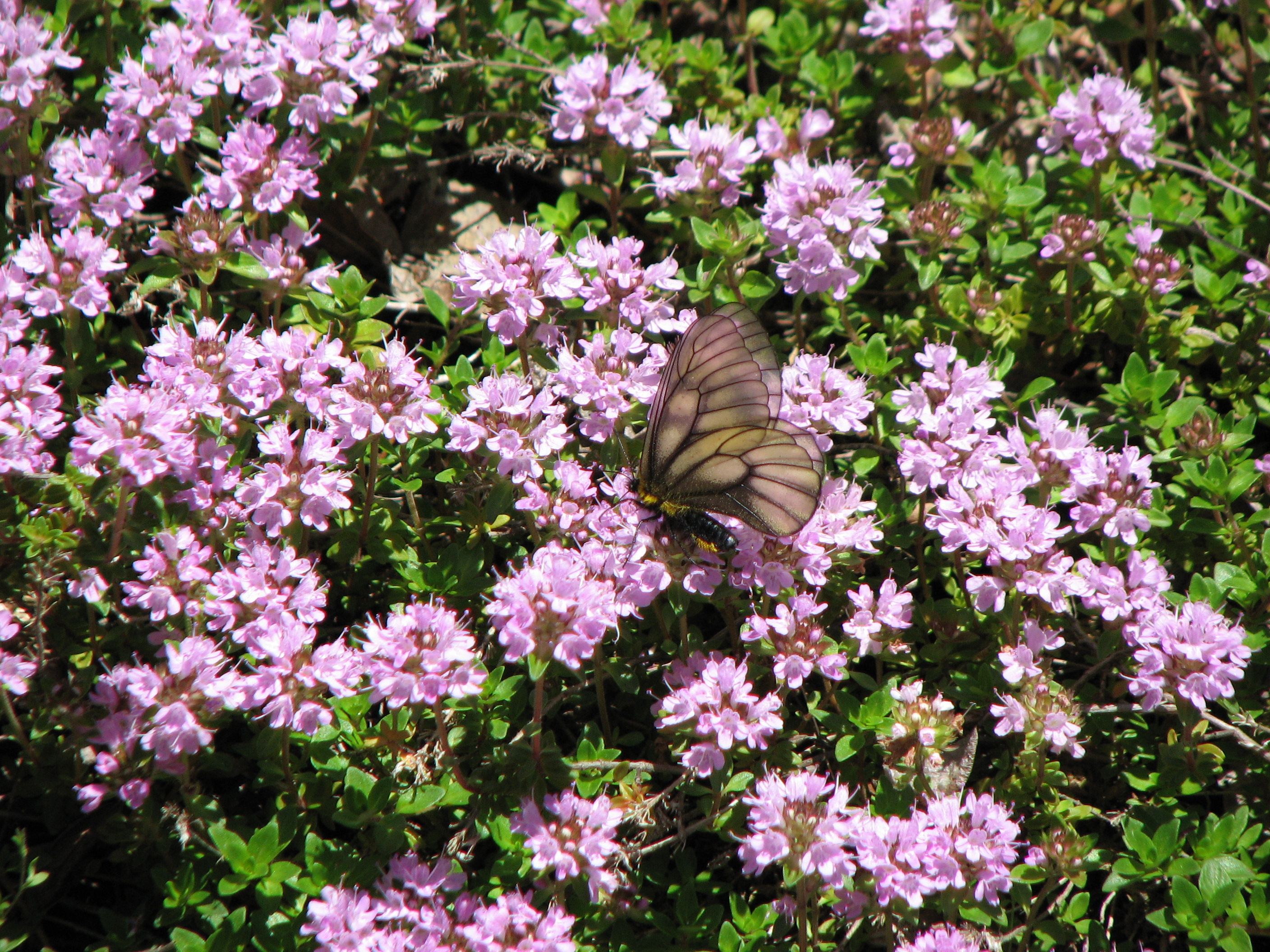
Botanical Name: Umbellularia californica


Botanical Name: Umbellularia californica
Common Name: California bay laurel, Oregon myrtle
Family: Lauraceae
Distribution/Origin: west coast of US
Leaf: smooth margins, elliptic to lanceolate, deep green, shiny dusty gloss
Bud: alternate
Flower: umbels, yellow to yellow green, hermaphrodite
Fruit/Seed: round green fruit, lightly spotted with yellow, maturing purple, large nut inside, dried and ground up for culinary use
Stem/Bark: hard, close grained, heavy, strong, light grey-reddish-brown, can be trained to single leader
Size: up to 82’ height, 32’ spread
Habit: suckering
Form: rounded, vase
Soil conditions: humusy, sandy loamy clays, well drained
Moisture: regular until established
Sun: full sun
Exposure: drought tolerant when established, regenerate after fires of light to moderate intensity
Landscape use: woodland garden canopy, large areas, specimen, hedge
Notes: the chemical responsible for the headache inducing effects of Umbellularia is known as Umbellulone 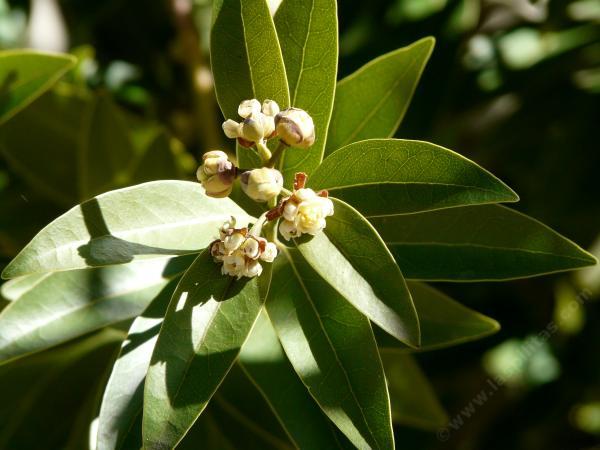
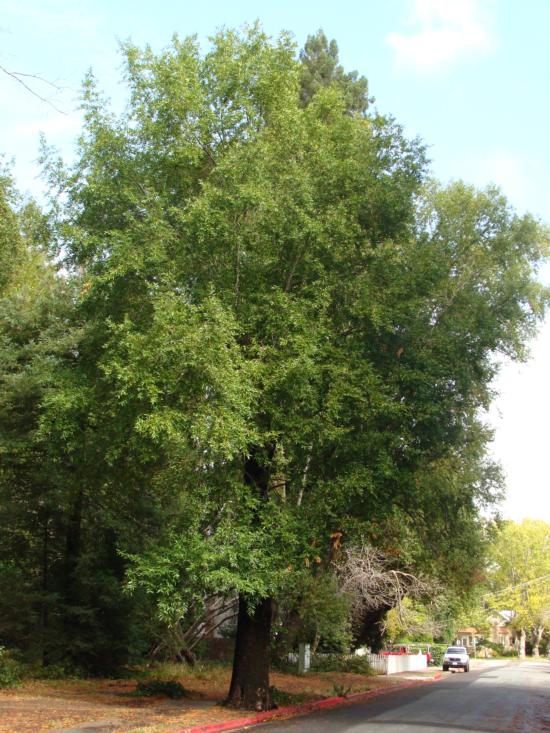
No comments:
Post a Comment